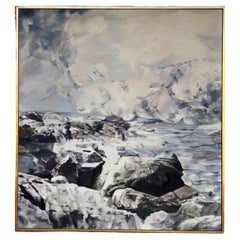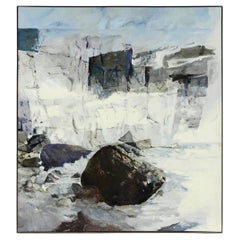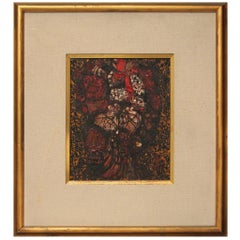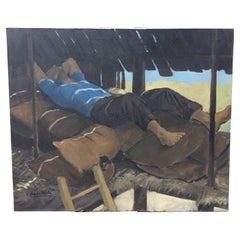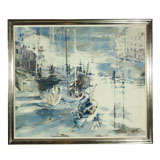Balcomb Greene Furniture
American, 1904-1990
Balcomb Greene has been described as "an iconoclast, a painter who has refused to conform to the latest artistic trends." This comment was apt, for Greene was an independent-minded artist who followed his own aesthetic inclinations regardless of what was in vogue among critics and the public. At the outset of his career, he eschewed Depression-era realism in favor of a cutting-edge geometric abstract style that set him apart from the mainstream art establishment and from many of his fellow abstractionists. During the 1940s, when non-representational painting came into fashion, he began to incorporate the human form into his work, creating enigmatic figure paintings in which variations of light and shadow played a vital role in creating mood.
A turning point in his career occurred in 1931, when Greene and his wife, Gertrude Glass Greene, traveled to Paris to further their understanding of vanguard art and literature. Although Greene intended to write novels in his Montparnasse studio, he soon found himself drawn to the art world and decided to become a painter. He was especially inspired by the example of Piet Mondrian, Juan Gris and the Abstraction-Creation painters, who sought to eliminate all references to nature, literature and anecdote by focusing on pure abstraction.
Greene returned to the United States in 1932, going on to develop his own hard-edged abstract style, creating what he referred to as "straight line, flat paintings." In 1937, he became a founding member and first chairman of Abstract American Artists, established to promote the cause of abstraction in national art circles. In the 1930s, Greene found employment with the Works Progress Administration's Federal Art Project. He created an abstract mural for the Federal Hall of Medicine at the World's Fair of 1939.
In 1940, Greene began studying art history at New York University, going on to receive a master's degree in 1943. During this period, his aesthetic approach changed as he abandoned the crisply rendered and brightly colored forms of his geometric work in favor of the figure shown against a backdrop of fragmented planes. He went on to create paintings, often naturalistic depictions of the female nude, that were characterized by an expressionist handling of paint and a limited palette of whites, greys and other muted tones that derived from his interest in photography. In 1947 Greene purchased some land on Montauk Point, Long Island. With the exception of a trip to Paris in 1958-60, he spent most of his time on Long Island, where he was one of the pioneers of the East End art colony. Inspired by the proximity of the ocean, he painted a number of marines, using dynamic brushwork to evoke the energy and spirit of the sea.
Greene taught aesthetics and art history at the Carnegie Institute of Technology in Pittsburgh (1942-47), where his students included Andy Warhol and Philip Pearlstein.(Biography provided by Lincoln Glenn)
2
2
2
2
2
2
2
1
1
1
1
2
2
2
2
2
2
5,177
4,015
2,458
2,235
Creator: Balcomb Greene
Balcomb Greene Wind Ocean Sun 1963
By Balcomb Greene
Located in Hudson, NY
Wind, Ocean, Sun by Balcomb Greene painted in 1963. Signed on the front titled and dated on the reverse.
Paintings of the Montauk coast by Balcomb Greene are few and far between. Thi...
Category
1960s American Mid-Century Modern Vintage Balcomb Greene Furniture
Materials
Canvas, Paint
Balcomb Greene "The Cliffs", 1978
By Balcomb Greene
Located in Hudson, NY
The Cliffs by Balcomb Greene painted in 1978. Signed on the front titled and dated on the reverse.
Paintings of the Montauk coast by Balcomb Greene are few and far between. This painting likely created at his Studio in Montauk New York. Painting is in excellent original condition and retains the original gallery frame.
provenance: Estate of Gertrude B. Pascal / Gifted from the previous in 1987, The Frances Lehman Loeb Art Center, Vassar College, Poughkeepsie, NY / Christie's, New York 2012 / Private Collection, New Jersey
Public collections:
Baltimore Museum of Art, Baltimore, MD
Brooklyn Museum, Brooklyn, NY
Cleveland Museum of Art, Cleveland, OH
The Art Institute of Chicago, Chicago, IL
Corcoran Gallery of Art, Washington, D.C.
Guild Hall, East Hampton, NY
Wadsworth Atheneum, Hartford, CT
Museum of Fine Arts, Houston, TX
Indianapolis Museum of Art, Indianapolis, IN
Metropolitan Museum of Art, New York, NY
Museum of Modern Art, New York, NY
National Museum of American Art, Washington, D.C.
Joslyn Art Museum, Omaha, NE
Pennsylvania Academy of the Fine Arts, Philadelphia, PA
Norton Simon Museum, Pasadena, CA
Portland Museum of Art, Portland, OR
Neuberger Museum, Purchase, NY
Solomon R. Guggenheim Museum, New York, NY
Parrish Museum, Southampton, NY
Whitney Museum of American Art, New York, NY
Walker Art Center, Minneapolis, MN
Butler Institute of American Art, Youngstown, OH
Boca Museum of Art, Boca Raton, FL
Over a lifespan of 86 years, Balcomb Greene followed his muse wherever it led, unfettered by what had come before, unafraid of where the future might lead. Despite a series of different pathways explored, his purpose remained ever constant: to express truth as he found it and communicate it to a broader audience. In the 1930s, Greene was a young artist committed to abstraction as his expressive language. Greene’s paintings and collages of the 1930s reflect the influence of Pablo Picasso and Piet Mondrian and put him in the company of fellow Americans, including Ibram Lassaw, Josef Albers, Ilya Boltowsky and George L. K. Morris, all among the founding members, in 1936, of American Abstract Artists.
John Wesley Greene, his christened name which he never legally changed, was born in 1904 in Millville, New York, the third child and only son of Methodist minister The Reverend Bertram Stillman Greene (1864–1929) and Florence Stover Greene (1876–1911). His family on both sides were Revolutionary-era colonists, originally living in Connecticut and Vermont before joining the Yankee migration to the western frontier of New York State. In 1922, John Wesley Greene enrolled at Syracuse University aided by a scholarship for the sons of Methodist ministers and intending to fulfill the promise of his name and follow his father into the ministry. As with so many before and after him, the liberal education he absorbed at Syracuse broadened his horizons and reshaped his life plan. Studying philosophy, psychology, and literature, along the way he separated himself from organized religion. During his senior year, on a visit to The Metropolitan Museum of Art in New York City, Greene was introduced to Gertrude Glass (1904–1956), an art student and the Brooklyn-born daughter of Latvian Jewish immigrants.
Following Greene’s graduation, the two married in 1926 and went to Europe. They stopped briefly in Paris but spent most of their time in Vienna where Greene had a fellowship to study psychology. When they returned to New York in 1927, Greene enrolled in a master’s program in ‘English literature at Columbia University. When his thesis advisor rejected his essay topic on the “fallen woman” in seventeenth-century literature as inappropriate, he left without a degree. From 1928 until 1931, Greene taught English at Dartmouth College in Hanover, New Hampshire. At some point, he stopped using his given name, John, and began to call himself, more distinctively, Balcomb, the family name of his paternal grandmother.
While Greene wrote three novels (all unpublished) during his teaching years at Dartmouth, his wife was a working artist, and he eventually developed an interest of his own in painting. In 1931, Greene gave up his teaching position and he and Gertrude went to Paris, determined to immerse themselves in the modern art ferment they had briefly experienced in their earlier visit. For young Americans with no prescribed agenda, a receptiveness to innovation, and wide-open eyes and minds. Paris, in 1931, offered a rich stew of approaches to modern art. The city absorbed and transmuted an international mélange of styles—cubism, orphism, futurism, dadaism, constructivism, neoplasticism, suprematism, de Stijl, Bauhaus—France encountering Holland, Germany, Italy, and Russia with Pablo Picasso from Spain, Constantin Brancusi from Romania, and Jacques Lipchitz from Lithuania. As a sculptor, Gertrude Greene...
Category
1970s American Mid-Century Modern Vintage Balcomb Greene Furniture
Materials
Canvas, Paint
Related Items
Mario Prassinos Oil on Canvas 1963
By Mario Prassinos
Located in Encino, CA
Mario Prassinos (1916-1985).
Oil on canvas, signed and titled 9 Jan 63 (January 9th 1963).
This subject is well-known in the artist work, Prassinos called it "portrait - Bouque...
Category
1960s French Vintage Balcomb Greene Furniture
Materials
Paint
Resting Farmer Italian Figurative Painting by Bocassile, 1978 circa
Located in Milan, IT
Italian oil on canvas unfraimed painting featuring a resting farmer lying in the shade of a barn.
Signed lower left Boccasile by Giorgio Boccasile Italian p...
Category
1970s Italian Expressionist Vintage Balcomb Greene Furniture
Materials
Canvas
Daniel Pipard ‘1914-1978’ Oil on Canvas "Vase De Fleur Sur Une Commode"
Located in Saint-Ouen, FR
Daniel Pipard ‘1914-1978’ oil on canvas "Vase De Fleur Sur Une Commode"
signed.
Category
Late 20th Century European Mid-Century Modern Balcomb Greene Furniture
Materials
Paint
H 25.2 in W 19.3 in D 1.19 in
Leonardo Nierman 1963 Abstract Oil Painting
By Leonardo Nierman
Located in Phoenix, AZ
Leonardo Nierman Mendelejis (1 November 1932 – 7 June 2023) was a Mexican painter and sculptor with a background in music. His musical training had a deep influence on his artwork, w...
Category
1960s Mexican Mid-Century Modern Vintage Balcomb Greene Furniture
Materials
Paint
Deep Ocean, Contemporary Color-Field Abstract by Benjamin Casiano
By Benjamin Casiano
Located in Philadelphia, PA
Evocative color-field abstract composition by contemporary American artist, Benjamin Casiano. Casiano is a lover of color and uses dramatic brushstrokes to bring color alive on his c...
Category
21st Century and Contemporary American Mid-Century Modern Balcomb Greene Furniture
Materials
Canvas, Acrylic
Free Shipping
H 48 in W 36 in D 1 in
Tommi Parzinger "Butterflys" Oil On Burlap, 1963
By Tommi Parzinger
Located in Norwalk, CT
Tommi Parzinger, German/NY (1903-1981).
"#4 Butterflys" Oil on burlap, 1963. Numbered, titled, dated and signed verso. Burlap stretched over wood frame....
Category
1960s American Mid-Century Modern Vintage Balcomb Greene Furniture
Materials
Burlap, Paint
"Baby" by Robert Kushner, 1978
By Robert Kushner
Located in Palm Springs, CA
Watercolor on paper by the noted artist Robert Kushner. It is on 3 pieces of paper affixed to a board backing. Signed and dated 1978 lower right and titled "Baby" lower left. Origina...
Category
1970s American Vintage Balcomb Greene Furniture
Materials
Paint
Painting "Church by the cliff"
Located in Chorzów, PL
Painting "Church by the cliff"
Dimensions:
Frame: Height 42.5 cm / width 47.5 cm / depth 4.5 cm
Image: Height 33.5 cm / width 38.5 cm.
Category
1950s Scandinavian Scandinavian Modern Vintage Balcomb Greene Furniture
Materials
Canvas, Wood
1950's Modernist Cityscape Framed Oil on Canvas by Greene
Located in San Diego, CA
A very interesting oil on canvas cityscape made by Greene framed in original condition.
Category
20th Century Balcomb Greene Furniture
Materials
Canvas
Montague Dawson: Wind Aft, The Repulse
By Montague Dawson
Located in Lymington, Hampshire
This watercolour on paper is framed under glass and signed in the left corner. It shows the East Indiaman sailing downwind under full canvas. The reverse has a paper trade label fr...
Category
Mid-20th Century English Balcomb Greene Furniture
Materials
Paper
DAVID LANGDON - 'Cliffs of Dover' - Contemporary Oil Painting - Signed - C. 2000
Located in Chatham, ON
DAVID LANGDON - 'Cliffs of Dover' (untitled) - Contemporary oil painting on canvas board - signed lower right - unframed - Canada - circa 2000.
Excellent condition - no loss - no da...
Category
21st Century and Contemporary Canadian Modern Balcomb Greene Furniture
Materials
Canvas, Paint
H 16 in W 20 in D 0.13 in
Mid Century Modern Vintage Multicolored Mid-Century Oil Painting, 1963
Located in Vienna, AT
Mid Century Modern oil on carton painting with a multicolored motif
"Many intelligent heads".
The painting is signed and framed with a chromed frame.
good condition
approx. measures:...
Category
1960s Mid-Century Modern Vintage Balcomb Greene Furniture
Materials
Paper
H 31.11 in W 40.56 in D 1.97 in
Previously Available Items
Balcomb Greene "The Squall", 1963
By Balcomb Greene
Located in Hudson, NY
The Squall by Balcomb Greene painted in 1963. Signed on the front titled and dated on the reverse.
Paintings of ships by Balcomb Greene are few and far between. This painting likely created at his Studio in Montauk New York or possibly while traveling in Maine. Painting is in excellent original condition and retains the original gallery frame. Purchase from a private collection in Chicago Illinois.
Public collections:
Baltimore Museum of Art, Baltimore, MD
Brooklyn Museum, Brooklyn, NY
Cleveland Museum of Art, Cleveland, OH
The Art Institute of Chicago, Chicago, IL
Corcoran Gallery of Art, Washington, D.C.
Guild Hall, East Hampton, NY
Wadsworth Atheneum, Hartford, CT
Museum of Fine Arts, Houston, TX
Indianapolis Museum of Art, Indianapolis, IN
Metropolitan Museum of Art, New York, NY
Museum of Modern Art, New York, NY
National Museum of American Art, Washington, D.C.
Joslyn Art Museum, Omaha, NE
Pennsylvania Academy of the Fine Arts, Philadelphia, PA
Norton Simon Museum, Pasadena, CA
Portland Museum of Art, Portland, OR
Neuberger Museum, Purchase, NY
Solomon R. Guggenheim Museum, New York, NY
Parrish Museum, Southampton, NY
Whitney Museum of American Art, New York, NY
Walker Art Center, Minneapolis, MN
Butler Institute of American Art, Youngstown, OH
Boca Museum of Art, Boca Raton, FL
Over a lifespan of 86 years, Balcomb Greene followed his muse wherever it led, unfettered by what had come before, unafraid of where the future might lead. Despite a series of different pathways explored, his purpose remained ever constant: to express truth as he found it and communicate it to a broader audience. In the 1930s, Greene was a young artist committed to abstraction as his expressive language. Greene’s paintings and collages of the 1930s reflect the influence of Pablo Picasso and Piet Mondrian and put him in the company of fellow Americans, including Ibram Lassaw, Josef Albers, Ilya Boltowsky and George L. K. Morris, all among the founding members, in 1936, of American Abstract Artists.
John Wesley Greene, his christened name which he never legally changed, was born in 1904 in Millville, New York, the third child and only son of Methodist minister The Reverend Bertram Stillman Greene (1864–1929) and Florence Stover Greene (1876–1911). His family on both sides were Revolutionary-era colonists, originally living in Connecticut and Vermont before joining the Yankee migration to the western frontier of New York State. In 1922, John Wesley Greene enrolled at Syracuse University aided by a scholarship for the sons of Methodist ministers and intending to fulfill the promise of his name and follow his father into the ministry. As with so many before and after him, the liberal education he absorbed at Syracuse broadened his horizons and reshaped his life plan. Studying philosophy, psychology, and literature, along the way he separated himself from organized religion. During his senior year, on a visit to The Metropolitan Museum of Art in New York City, Greene was introduced to Gertrude Glass (1904–1956), an art student and the Brooklyn-born daughter of Latvian Jewish immigrants.
Following Greene’s graduation, the two married in 1926 and went to Europe. They stopped briefly in Paris but spent most of their time in Vienna where Greene had a fellowship to study psychology. When they returned to New York in 1927, Greene enrolled in a master’s program in ‘English literature at Columbia University. When his thesis advisor rejected his essay topic on the “fallen woman” in seventeenth-century literature as inappropriate, he left without a degree. From 1928 until 1931, Greene taught English at Dartmouth College in Hanover, New Hampshire. At some point, he stopped using his given name, John, and began to call himself, more distinctively, Balcomb, the family name of his paternal grandmother.
While Greene wrote three novels (all unpublished) during his teaching years at Dartmouth, his wife was a working artist, and he eventually developed an interest of his own in painting. In 1931, Greene gave up his teaching position and he and Gertrude went to Paris, determined to immerse themselves in the modern art ferment they had briefly experienced in their earlier visit. For young Americans with no prescribed agenda, a receptiveness to innovation, and wide-open eyes and minds. Paris, in 1931, offered a rich stew of approaches to modern art. The city absorbed and transmuted an international mélange of styles—cubism, orphism, futurism, dadaism, constructivism, neoplasticism, suprematism, de Stijl, Bauhaus—France encountering Holland, Germany, Italy, and Russia with Pablo Picasso from Spain, Constantin Brancusi from Romania, and Jacques Lipchitz from Lithuania. As a sculptor, Gertrude Greene was fascinated by the constructivism of the Russian brothers Naum Gabo and Antoine Pevsner as well as the work of Brancusi, Jean Arp, and Jacques Lipshitz. Initially, according to plan, Gertrude sculpted while her husband continued to write. Soon, however, Greene felt the pull of the expressive possibilities of paint and registered for instruction at the Académie de la Grande Chaumière, an inexpensive and loosely organized school.
Balcombe Greene found in abstraction the means of communication that had eluded him as an aspiring minister, as a psychologist, and as a teacher and writer of fiction. Artists had long recognized the influence of hidden geometries in influencing viewer’s perceptions and reactions to their works. Twentieth-century abstraction or “non-objective” art, dispensed with recognizable figural images and manipulated geometry and color, aiming, as with earlier art, to reach the viewer on a level below conscious awareness. This would be art in a new language for a new society...
Category
1960s American Mid-Century Modern Vintage Balcomb Greene Furniture
Materials
Canvas, Paint
Oil on Canvas Signed Balcomb Greene
By Balcomb Greene
Located in Stamford, CT
A fine oil on canvas signed Balcomb Greene of Sailing boats on a canal. Title Thunder under the Sea. In a fine silverd frame. Listed USA artist, 1904-1990.
Category
20th Century American Balcomb Greene Furniture
Materials
Canvas
Balcomb Greene furniture for sale on 1stDibs.
Balcomb Greene furniture are available for sale on 1stDibs. These distinctive items are frequently made of paint and are designed with extraordinary care. Many of the original furniture by Balcomb Greene were created in the mid-century modern style in united states during the 20th century. If you’re looking for additional options, many customers also consider furniture by Lowell Nesbitt, Miriam Kubach, and Harry Bouras.
